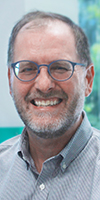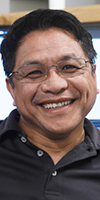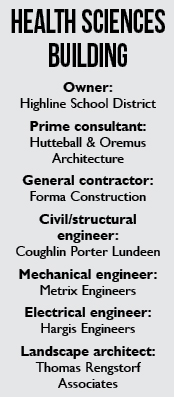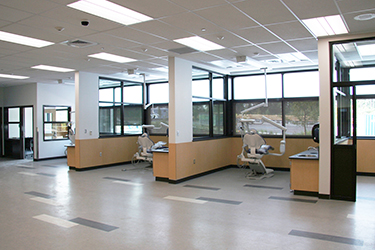|
Subscribe / Renew |
|
|
Contact Us |
|
| ► Subscribe to our Free Weekly Newsletter | |
| home | Welcome, sign in or click here to subscribe. | login |
Construction
| |
 |
August 24, 2017
High schoolers get real-life work experience in health sciences building
Hutteball & Oremus Architecture

Chaput
|

Tam
|
Students usually have to wait until after high school to start gaining hands-on learning experiences for their future careers. At the Puget Sound Skills Center in Burien, students are given the opportunity to start learning these skills in high school through one of the specialized program offerings.
Since 1966 the Puget Sound Skills Center, the first skills center in Washington state, has been preparing high school students to be career-ready or college-bound upon graduation. With Highline School District as the host district, the skills center partners with four other school districts — Federal Way, Fife, Tahoma and Tukwila — to offer 18 distinct career programs with certifications or college credits.
Real-world environments
Puget Sound Skills Center will open a new two-story, 26,500-square-foot Health Sciences Building in September. It will house a dental assistant program, nursing assistant program, a new biomedical program and the SeaMar Dental Clinic.
The new building is located in the heart of campus, just south of the original main building. Separated by a connective courtyard that will serve as a gathering space for students and the community, it augments existing programs by utilizing that space for outdoor training for emergency responders.
The Health Sciences Building can be seen along Des Moines Memorial Drive. Its contemporary design, expressive use of angles and volumetric forms gives the building a distinct presence on campus.
Although msodern in design, the building pays homage to the original building in its use of colors and materials, seamlessly connecting the buildings into a unified campus. The interior materials, colors and finishes are all consistent with those found in current medical and health care facilities, helping to create the feel of a professional work environment.
One key success was the extensive programming with industry partners and professional experts, who provided valuable input and feedback from the beginning stages of the design process. Their feedback provided insight into the professional needs of each of the programs and the work environments found in their industries.
From early design consideration, it was important to provide real, professional settings for the students to learn and develop potential career paths. The classrooms and lab spaces were designed to enhance and facilitate the teaching methodologies for the students and staff alike.

By juxtaposing the lab and classroom spaces, the teaching and learning process allows a seamless transition from lecture to hands-on learning. The idea of merging a professional, hands-on practice within an educational environment has been a major influence on how the building functions and feels.
A next-door clinic
The design of the new dental lab doubles the capacity of the program to provide space for students interested in the dental industry.
The dental lab mimics the environment found in a professional dentist office, including a reception desk for students to thoroughly learn the process of interacting with a patient from greeting through checkout. The program offers real professional-grade equipment, including four professional patient dental chairs, a stone lab for castings, dedicated panoramic X-ray room, sterilization station and laundry facility.
An important aspect of the Health Sciences Building is the relationship of a professional dental practice within the building and its proximity to the instructional spaces of the dental lab.
SeaMar Dental Clinic leases space from the skills center and operates as a not-for-profit organization providing dental care to low-income patients and families. The connection of the clinic and instructional areas allows students to work side-by-side with dental assistants and observe actual dental treatment.
Just as the dental lab emulates the environment of a dental office, the nursing lab simulates the environment of a hospital for the nursing assistant program.
When students arrive at the nursing lab, they will enter a changing room where they transition from their street clothes into scrubs, as they would at a clinic or hospital. There are eight hospital beds with a nursing head wall, where students can learn and practice proper patient care. As a part of the nursing lab, there is an instructional bathroom where students learn the proper way to assist a disabled or injured patient.
Even the elevators found in the Health Sciences Building are sized for gurneys to move from one floor to another with ease.
The newest program at the skills center is the biomedical program, which was added through the design of the new Health Sciences Building. The program will allow students the opportunity to learn how biological and physiological sciences apply to clinical medicine with the use of professional lab equipment such as carbon-dioxide incubators to grow cultured cells, a minus-20-degrees-Celsius freezer for storing enzymes and chemicals, an incubator for bacterial plates, and a refrigerated centrifuge to separate fluids, solids and gases.
At the heart of the Health Sciences Building is a flexible lecture hall large enough to accommodate the entire student body of the Puget Sound Skills Center. The design utilizes a vertically folding, operable glass wall to integrate the multipurpose space and the second-floor walkway for community lectures or events. By providing the flexible space, students in the culinary arts program are given the exciting opportunity to prepare and execute professional catering services.
Bill Chaput is a principal at Hutteball & Oremus Architecture. Calvin Tam is an intern architect at the firm.
Other Stories:
- Giant murals give students ‘something to look at and feel proud’
- Seattle’s Lincoln High to reopen 38 years after closing
- Outdoor learning labs let children connect to nature
- Tahoma High project makes the best of a hilly site on former golf course
- North Seattle elementary supports students by opening its doors to families
- Designers study Tinkertoy-inspired school 20 years later to see what worked
- 2 new buildings that push students to become more engaged learners
- Classroom wing provides West Sound’s first new STEM space
- Why an old church could make a good place for a charter school



